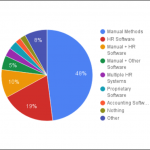The Future Of HR And Why Startups Shouldn’t Reject It
In 2012 a curious person on the web—likely an enthusiastic entrepreneur—asked a simple question on Quora: Does a startup need an HR person? This was in the infancy of the current boom—or bust—we’re now in; Now-defunct shopping website Fab had just raised $117 million; Pinterest landed $100 million, Box raised $125 million, and Square got $200 million.
Startups at the time were figuring out how to ride this wave, so it’s unsurprising that the first and most popular answer provided was this: “No, you don’t need an HR person.”
Things have changed since then. For one, many believe the startup boom may be coming to an end, what with the rate of venture funding—along with many valuations—ramping downward. Startups are also being forced to grapple with their internal cultural problems; big companies like Twitter, Google, and Apple are being asked to divulge their internal demographics thanks to widespread calls for a more open and transparent work culture. But even with an insular industry seeing slightly more public dialog about its intrinsic biases and inequalities, startups still have difficulty figuring out how to maintain and cultivate their workforce. And this aversion to HR may explain some part of that.
The phrase “HR is dead” is oft-repeated in startup circles—indeed Fast Company wrote a story about its shortcomings in 2005—but it’s unclear what’s at stake when companies overlook this sort of fundamental structure.
A recent Motherboard piece took a look at the impact of no HR on company culture. It found that women are more often than not the most vulnerable employees due to startups’ lack of HR and general anti-harassment procedures. The article states, “Ultimately, these structural issues contribute to one of the greatest systemic problems facing working women today: barriers to advancement, known to many as the glass ceiling.” And over the years some of the biggest tech startups have had accusations of harassment levied at them.
Github is probably one of the most memorable examples. In 2014 a female engineer left the company and went public with allegations of being targeted and harassed by one of the cofounders and his wife. The company, following an investigation of the company’s actions, found no legal wrongdoing, ultimately sweeping this saga under the rug. A few months later, however, GitHub announced it would make its HR procedures more robust, a move that could have perhaps made the original incident less of public spectacle.
These sorts of instances bring to light the fact that harassment in the workplace is not uncommon, especially in Silicon Valley. A recent survey of women in tech in the Valley revealed that 60% had experienced unwanted sexual advances in the workplace. The same number of women also said that when they reported instances of harassment, they were dissatisfied with the results.
What Is The Purpose Of HR?
This leads to the question, what exactly is the function of HR, and why is it historically so despised? Human Resources has become a catch-all for all the functional but non-flashy parts of an organization: hiring, payroll, health insurance, and all other administrative things.
As Libby Sartain, a former HR executive who worked at both Yahoo and Southwest Airlines, sees it, startups’ resistance to formal human resources is an issue of culture. “In the old days,” says Sartain, HR was primarily administration—”to get people on payroll.” But now companies are more reticent about adding an additional layer. “I see companies concerned about their culture,” she says.
But this cultural issue is a double-edged sword. Startups are focused on growth and wooing talent by talking about how fun and casual their company is. Indeed, the idea of startup culture—one that has beer on tap and ping pong tables—is a direct response to bureaucratic rigmarole like a human resources department killing a buzz. But the startup stigma with HR has the potential to create unintended consequences: what happens when someone doesn’t fit into that culture. And when those problems happen, it’s departments like HR that usually attempt to fix the issues.
“There are a lot of younger people,” says Sartain, “who don’t understand the importance of ethical behavior in the workplace.” And without the proper safeguard in place, this can lead to a hostile work environment. She adds, “I think some of the younger people haven’t learned what kind of behavior is acceptable and what kind of behavior is unacceptable.”
Of course, more common are simply the cultural misunderstandings. A work setting of predominately white males in their twenties can easily turn into an unwelcome environment for anyone not within those boundaries. And this hostility could easily be due to tone deafness. Often, founders are younger people railing against the perceived bureaucratic norms of a widespread HR department. Yet they still aren’t aware of the environment they cultivate for people different from them.
All the same, when unacceptable behavior does happen, it leaves those at the receiving end with very few options. That’s when employees would normally seek out HR for help, but instead turn to an attorney or go to the media. Thus, business veterans like Sartain believe it’s imperative to have some system in place for these sorts of situations. At the very least, there should be a policy in place clearly stating what a founder should do when faced with such a complaint.
Software As A Substitute
On the other end of the spectrum is the issue of cost. Small businesses obviously can’t afford to hire a team to do their administrative work. Instead they are now turning to outsourced or software-built services that fill the gaps. Trinet, Zenefits, and Justworks, for example, offer digital dashboards to onboard and keep track of employees similar to what a traditional HR person would do in the past. But, as one startup founder wrote in a review of the Zenefits platform, “[It’s] especially great for early stage companies, but once you reach about 50 employees, you’ll need something more.”
These services, however, capitalize on being the answer for small companies looking to automate menial tasks. Isaac Oates, founder and CEO of Justworks, says he saw an opening for this kind of bureaucratic platform. He wanted to a build a software solution that would “just do all the stuff that needs to happen.” Justworks makes it possible for small businesses to automate their payroll, benefits, and regulatory data. These are the kinds of tasks an entire department would have done a decade ago. The focus is precisely on those small businesses that don’t have the resources to bring new humans on. With that, Justworks represents a new cadre of solutions that turn people into software. Employees get their pay stubs through the platform, along with benefits information.
Amanda Moskowitz, founder of the startup leadership sharing resource Stacklist, sees these as one of the big ways startups are adapting to HR needs. Instead of hiring one or two new positions, companies are seeking out more siloed products in lieu of an entire human resources department. “While we don’t see founders saying they’re using X tools and calling it HR,” she said, “They are using review tools.” These include products, like Glint and Small Improvements, which allow employers to keep track of their workforce, along with opportunities for employees to provide formal feedback.
It seems almost like a way for companies to maintain their own cultural identity without giving the illusion of a corporate structure. This denial of HR culture, she adds, is just because of the way it’s been perceived and presented for years. Now companies offer services that fix the problems as a user interface problem; Justworks is a dashboard that automates the entire employee-management process, which seems more palatable than hiring a new, standalone department.
But it leaves a gap for where a human department once was. Though these HR platforms help businesses stay compliant with state and federal labor laws, they don’t provide the same buffer that departments had before. And, perhaps most apparent, a software or automated platform cannot replace the human experience of talking with someone, especially dealing with sensitive issues like health and well-being. While some may say that role can fall on leadership, having a position for just that type of conversation changes the dynamic. If an employee feels uncomfortable in the workplace, he or she can’t log on the dashboard and report the event (although Justworks does offer HR-specific consulting that connects founders with experts when faced with an unexpected event).
This leads to the question of whether or not HR is really the issue at hand. If you have a small company of 10-25 people and an employee has very specific, personal needs, would a formal HR associate be what is needed to help the problem? Oates says more often than not, these human relations issues can be boiled down to leadership, and likely aren’t even part of the human resources umbrella. When a company is faced with a sensitive issue it’s never dealt with before, how a company responds is reflective of the startup’s leadership. “Setting the tone of the organization,” says Oates, “that’s never going to be HR.”
The Future..?
All the same, there is undeniably a push to bring these legacy services into today’s companies. Though the nomenclature has changed, the problems have persisted for decades. In a follow-up email Moskowitz mused that perhaps what’s really changed is that things are more unbundled. New companies don’t like the idea that they’re using old tactics. “It might also lead them to say that they are rejecting HR,” she wrote, “even though they’re really just rejecting legacy tools, not the core concepts like comp, compliance, team productivity, and employee happiness.”
Indeed some organizations are seeking out new ways to make employees feel more included. While perhaps not strictly under the human resources umbrella, a few high profile technology companies have begun hiring heads of diversity. The real question is whether these moves are lip service to look good in the public eye, or if they will help bring about actual cultural change within the white bro confines of the startup world.
Part of this equation is ensuring that people have safeguards within their organization. With pushes for more diversity and safeguards in the workplace come an unspoken push for better—or more comprehensive—HR structures. Though the current trend seems to be product-oriented, there’s another quieter move toward figuring out how to make employees more comfortable, valued, and included.
And when dealing with cultural differences and employee needs, the best solutions are likely not software and dashboard based.
Fast Company , Read Full Story
(23)













